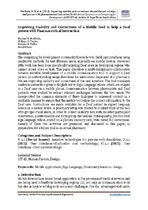| dc.contributor.author | Motlhabi, Michael B. | |
| dc.contributor.author | Tucker, William David | |
| dc.contributor.author | Parker, Mariam B. | |
| dc.contributor.author | Glaser, Meryl | |
| dc.date.accessioned | 2014-06-24T08:08:36Z | |
| dc.date.available | 2014-06-24T08:08:36Z | |
| dc.date.issued | 2013 | |
| dc.identifier.citation | Motlhabi, M. B., .et al. (2013). Improving usability and correctness of a mobile tool to help a deaf person with pharmaceutical instruction. In 4th Annual Symposium on Computing for Development (ACM DEV-4), Article 13. Cape Town, South Africa | en_US |
| dc.identifier.issn | 978-1-4503-2558-5 | |
| dc.identifier.uri | http://hdl.handle.net/10566/1102 | |
| dc.description.abstract | The computing for development community knows how to build user interfaces using qualitative methods for text il- literate users, especially on mobile devices. However, lit- tle work has been done speci cally targeting Deaf users in developing regions who cannot access voice or text. This paper describes a multi-disciplinary collaboration towards iterative development of a mobile communication tool to support a Deaf person in understanding usage directions for medication dispensed at a pharmacy. We are improv- ing usability and correctness of the user interface. The tool translates medicine instruction given in English text to Sign Language videos, which are relayed to a Deaf user on a mo- bile phone. Communication between pharmacists and Deaf patients were studied to extract relevant exchanges between the two users. We incorporated the common elements of these dialogues to represent content in a veri able manner to ensure that the mobile tool relays the correct informa- tion to the Deaf user. Instructions are made available for a Deaf patient in signed language videos on a mobile device. A pharmacy setup was created to conduct trials of the tool with groups of end users, in order to collect usability data with recorded participant observation, questionnaires and focus group discussions. Subsequently, pre-recorded sign language videos, stored on a phone's memory card, were tested for correctness. Results of these two activities are presented and discussed in this paper. | en_US |
| dc.description.sponsorship | Telkom, Cisco, Aria Technologies, THRIP, SANPAD | en_US |
| dc.language.iso | en | en_US |
| dc.publisher | ACM | en_US |
| dc.rights | Copyright ACM. This file may be freely used for educational purposes, as long as it is not altered in any way. Acknowledgement of the authors and the source is required. | |
| dc.source.uri | http://dx.doi.org/10.1145/2537052.2537063 | |
| dc.source.uri | http://dev4.acmdev.org/ | |
| dc.subject | User interfaces | en_US |
| dc.subject | Evaluation and method | en_US |
| dc.subject | User-centered design | en_US |
| dc.subject | Assistive technologies for persons with disabilities | en_US |
| dc.title | Improving usability and correctness of a mobile tool to help a Deaf person with pharmaceutical instruction | en_US |
| dc.type | Conference Proceedings | en_US |
| dc.privacy.showsubmitter | FALSE | |
| dc.status.ispeerreviewed | TRUE | |
| dc.description.accreditation | Web of Science | en_US |

